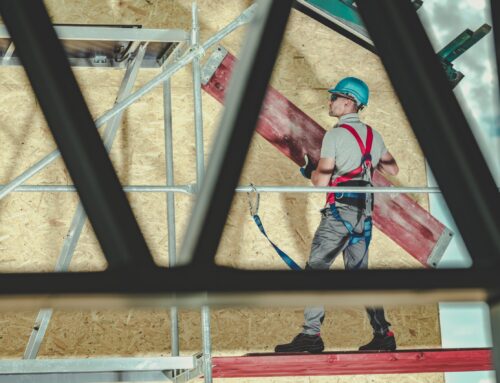This desire for measurement and feedback—for keeping score–is critical to how we live our lives. It is also the key to the success of our safety program. For one reason, it lets us know how well we’re doing. For another, it can serve as a motivating force to the extent that people in the workplace will make the effort to earn a “good score.” Let’s discuss how to measure safety performance and use measurement and feedback as a motivating force to exert positive change on our organization’s safety culture.
The Power of Measurement
Each of us uses measurements every day, both consciously and sub-consciously. Sometimes the act of gathering and analyzing data is as simple as a glance at a clock or gas gauge, a look at a bank statement or a check of the stock market report or a baseball box score. Sometimes the data is more complex such as reports on cycle times and quality yields. Each of these things provides us with valuable information that affects our decision-making and behavior.
But we are also bombarded with data and not all of it is equally important. To process data effectively, we need to be able to sort the important from the less important and analyze it, sometimes in milliseconds, sometimes in minutes and sometimes in hours. We either store the data in our brain for future use or act on it right away.
What We Keep Score of
Keeping score is a way to process data. The term keeping “track” or “score” generally suggests something fun rather than weighty, an activity or measure that is important to us even though it seems trivial or minor to others. For example, we keep score in recreational activities and sporting events.
The “score” may not always be measured by numbers. Sometimes we measure our level of satisfaction, pleasure or feeling of accomplishment. We know if we had a good time whether we were fishing, playing golf, scrap-booking, exercising, playing chess or even playing tic-tac-toe. Even though these measures are more subjective, we could quantify them if we had to.
How We Typically Measure Safety
Safety, or safety performance, by contrast, is something we generally deem too complicated to “keep score” of. Traditionally, we measure “safety” by analyzing what is not safety, that is, injury statistics occurring at each plant site such as recordable injuries, lost time accidents, number of lost or restricted days, workers’ compensation claims paid, etc.
But there are problems even with the data we use to measure “safety” in the traditional way. As safety professionals, we all agree that this injury data does not tell the whole story. For example, it does not indicate all that occurred; rather, it is a compilation only of what has been reported regarding undesirable events. It also doesn’t indicate the quantity or quality of the effort we put forth to maintain or improve safety. The occurrence of an injury measures only failure and doesn’t capture the positive things that were accomplished.
Moreover, all of these measures are “trailing” measures. They’re after the fact. And they lead to after-the-fact solutions that are akin to closing the barn door after the horses have already left.
How Trailing Indicators Hurt the Safety Culture
Current safety measurement systems don’t do justice to how we are performing relative to safety. Moreover, because of their lack of positive feedback and acknowledgement of positives achieved, they often serve to de-motivate employees and cause them to maintain negative attitudes toward safety.
The injury data that safety professionals have traditionally used to measure performance are trailing indicators. They identify problems and solutions only after incidents have occurred. The use of trailing indicators to measure safety generally produces a de-motivating effect. It leads to corrective actions that can be perceived by employees to be reactive. “The only time anything gets done around here is after someone gets hurt,” employees think. This causes employees to develop a negative view of safety and fosters doubt about the sincerity and level of management’s commitment to protecting them.
Once this approach to managing safety occurs a few times, it becomes the norm in the eyes of employees. This undermines the credibility of the safety program. Because employees feel that their safety interests are not in line with management’s, when an incident occurs employees tend to take a defensive attitude stating “it wasn’t my fault.” Couple this with another common negative perception held by employees that investigations are exercises in blame and fault-finding. These negative perceptions encourage employees to dismiss the pursuit of new safety programs and label them as a “flavor of the month.” Instead of motivating, our good intentions regarding safety become de-motivating.
Unfortunately, once they develop, these attitudes tend to become embedded in the culture of the organization. That makes them difficult to change.
Towards a Solution: Measuring “Safety” Not Injury
How do you solve this problem? The starting point is to consider our very definition of safety. Traditionally, safety has been thought of as the avoidance of incidents, accidents and injuries. But I submit that safety is actually the flip side of these things – it’s the state of being safe. It’s more of a behavior than an outcome.
Here’s an example. When we talk about a safe driver, we generally mean somebody who has not been in an accident, has not received a speeding ticket and has low insurance rates. Although these are good outcomes, they do not necessarily define the person as a “safe” driver. These outcomes could just as easily have been accomplished as a result of luck. Conversely, otherwise “good” drivers don’t necessarily become bad ones merely because they have the misfortune of getting into an accident that wasn’t their fault.
The truly “safe” driver is a person who engages in safe driving behavior – who uses turn signals, checks the blind spots when changing lanes, maintains the recommended distance behind the car in front, etc.
Another example: When we measure the performance of athletes, we look at the positive rather than the negative things they accomplish. A bowler is defined not by the number of gutter balls he throws but by how many pins he knocks down. A batter in baseball is evaluated not according to how often he strikes outs but by the number of times he reaches base.
Few safety professionals would argue with the logic of this. So why, then, is safety different? Why do so many of us use (or permit our management to use) a system of measuring safety that’s based on injury performance? As safety professionals, we must measure the right thing and use the right metrics. After all, if our decisions are based on faulty data, they’ll lead to faulty actions.
How Feedback Motivates Behavior
Many supervisors, managers and safety professionals fail to grasp the importance of feedback on measurement. Human beings by nature look to others to evaluate their performance. Why? We want to win, to be recognized for doing a good job and adding value. And we want to receive feedback as soon as possible, especially if we know we’ve done well.
Consider the example of sports. Games like baseball involve a steady stream of feedback while the performance is occurring, batter by batter, inning by inning. Figure skaters receive their feedback right after they skate their routine. In clock games like basketball, football and hockey, feedback in the form of the score and time remaining serve to motivate the players and the fans. Excitement builds when your team is ahead and the clock shows only a few seconds to go.
Applying the Lesson to Safety
Just think what we could do if we could build similar excitement and tension in safety. Sadly, we don’t use these feedback mechanisms to motivate safe behaviors. On the contrary, we only measure the negative behaviors like accidents and incidents. Sure, we provide feedback to our workers – but only to let them know that they have ‘screwed-up.’
Another big mistake managers make is waiting until the end of the month to provide feedback regarding safety performance. Feedback is best as a motivator when it’s delivered fresh, that is, during or right after the performance. It tends to get stale in a month and it can even be ineffective after only a week. Think about it. Have you ever done something you think deserves some form of recognition or acknowledgement and you don’t receive it until the following week? It isn’t the same as hearing back the next day, is it?
Changing Our Feedback Mechanisms
What should we do differently in the realm of safety performance? First of all, we need to define the right criteria to indicate successful performance. What is the “goal,” the “homerun,” the “touchdown?” In safety, we don’t do a good job of identifying the activities that equate to success. What we need to do is ask the question: Are we measuring what we have to do to win?
All too often, measuring safety performance falls into just being a numbers game that overlooks the value of the underlying activity being measured. Examples:
We typically measure and track numbers of employees who attend safety meetings. We shoot for a goal of 100% attendance. Although getting employees to show up at safety meetings is certainly important, the paramount concern, at least initially, should be the effectiveness of the meeting measured against pre-defined objectives. There are at least 15 safety meeting objectives that can easily be identified to be part of a simple survey that would be completed by attendees.
We routinely measure the number of safety audits performed against the required number for the month. But shouldn’t we be measuring the percentage of audits performed that have met the agreed upon objectives? For example, was feedback provided to individuals when warranted; were deficiencies handled appropriately; and were results communicated back to the area that was audited? These as well as other objectives could be easily answered by the audit team upon completion of the audit.
Safety suggestions are often measured by submittals per employee per year. Rather, shouldn’t we be measuring the effectiveness of safety suggestions – that is, the percentage of suggestions that have been successfully implemented, suggestions responded to within a certain period of time and feedback provided to the person who suggested it?
Scorekeeping and Safety
Sports has got it right because it keeps score. This is why so many people care deeply about the outcome of games involving their favorite team. This applies to players as well as fans who, even though they do not physically participate, have a psychological attachment to the team.
There’s real power in scorekeeping and that we as safety professionals can and must try to harness this power to improve safety performance. If we can identify the desired outputs, that is, the actual effectiveness of our safety-related activities, we will have a clearer understanding of what should be changed, continued and prioritized. We’ll understand the value of different outcomes and establish a frame of reference complete with our own version of singles, doubles, triples and home runs.
We can also put managers, supervisors and employees in the position to keep score of their performance and empower them to win. At that point, when everyone in the organization is playing the same game, using the same rules, on the same playing field and under the same understanding of how to win, we will be in a better position to achieve our safety outcomes and thereby, our safety goals. The result will be a highly motivated workforce and improved safety performance.
An Example of the Principles in Action
Let’s use a concrete example to help you turn these abstract principles into a plan for action. Assume you want to use safety meetings to improve performance. The typical approach would be to measure the number of attendees for each meeting. But, as we discussed last week, this is not the most appropriate measurement. The real starting point is to measure the effectiveness of the overall meeting itself. In other words, were the meeting objectives met and executed to a satisfactory level. After all, 100% attendance won’t improve safety if the substance of the meeting is devoid of any real value or was executed poorly.
One way to measure the effectiveness of safety meetings is to give attendees a survey to fill out with yes, no or N/A answers. The survey would have all the important objectives listed. Survey results would provide a way to assess whether safety meetings are “winning” (or improving) or not, shift by shift, month to month, or even supervisor to supervisor, if desired. The survey results would also serve to motivate the person providing the meetings to make appropriate changes or, if the results are very good, keep it as it is. The result will automatically drive continuous improvement in safety meeting performance of future meetings.
Measuring the Right Things
Get your measurement and feedback systems right and safety performance will improve due to the motivation to win. How do you do this? First, find the right things to measure. To do this, define the desired objectives for key activities and desired outcomes that will provide a positive safety culture at your organization. Elements you’ll want to include in addition to activities are:
- Management leadership and commitment to safety;
- Employee attitudes and motivation to work safely;
- Employee ownership and involvement in the safety program;
- Communication and feedback effectiveness; and
- The effectiveness of your current safety programs and initiatives, including incentive and recognition programs, employee suggestion programs, incident investigations, audits and inspections, management of change, work order system, committees and safety meetings.
Be sure to measure employee behavior at all levels of the organization including supervisors and management.
Establishing Goals and Delivering Feedback
Measurement doesn’t just gauge performance; it affects it. Remember the old saying: What you measure is what you get. Also remember the principles of keeping score. Give your employees a chance to win. Establish performance targets and define the desired outcomes of the programs you have established so they know how to win. Some people are self-motivated whereas others may need to have their scores posted or reviewed by others.
Goals should be defined in terms of actual vs. expected behavior. Once the desired outputs are defined, measured and the results communicated back to the appropriate individuals, everyone will be engaged in the process of continuous improvement. This method of measurement and feedback has been instrumental in providing safety managers in many industries with insight ands the capacity to allocate their resources more effectively.
Conclusion
Feedback and measurement can motivate or de-motivate. It all depends on the system we use. Unfortunately, the world of safety has things upside down. We measure failure (the occurrence of injuries and accidents) and deliver negative feedback (letting employees how they screwed up). What we get for these efforts is a workforce disenchanted with the safety program and unmotivated to behave safely.
Turn safety measurement into a motivating force to your advantage. Define your desired outputs and measure the extent the objectives are being met. Provide immediate feedback if possible, and positive encouragement to all employees, (don’t forget those on graveyards). Give employees a chance to win and establish a method of keeping score so they know what it takes to be a winner. Doing these things will put you on the road to improving safety performance and building a leading safety culture.






